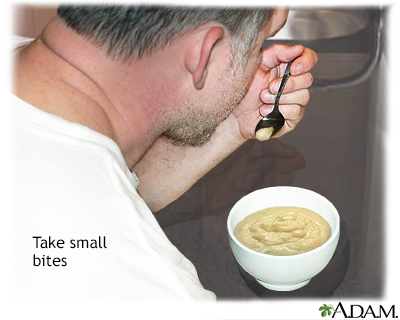Swallowing problems
Dysphagia
Images

I Would Like to Learn About:
Description
Difficulty with swallowing is the feeling that food or liquid is stuck in the throat or at any point before the food enters the stomach. This problem is also called dysphagia.
This may be caused by a brain or nerve disorder, stress or anxiety, or problems that involve the back of the tongue, the throat, and the esophagus (tube leading from the throat to the stomach).
What to Expect at Home
Symptoms of swallowing problems include:
- Coughing or choking, either during or after eating
- Gurgling sounds from the throat, during or after eating
- Throat clearing after drinking or swallowing
- Slow chewing or eating
- Coughing food back up after eating
- Hiccups after swallowing
- Chest discomfort during or after swallowing
- Unexplained weight loss
Symptoms may be mild or severe.
Home Care
Most people with dysphagia should be checked by a health care provider if the symptoms persist or come back. But these general tips may help.
- Keep mealtime relaxed.
- Sit up as straight as possible when you eat.
- Take small bites, less than 1 teaspoon (5 mL) of food per bite.
- Chew well and swallow your food before taking another bite.
- If one side of your face or mouth is weaker, chew food on the stronger side of your mouth.
- Do not mix solid foods with liquids in the same bite.
- Do not try to wash down solids with sips of liquids, unless your speech or swallowing therapist says this is OK.
- Do not talk and swallow at the same time.
- Sit upright for 30 to 45 minutes after eating.
- Do not drink thin liquids without checking with your provider or therapist first.
You may need someone to remind you to finish swallowing. It may also help to ask caregivers and family members not to talk to you when you are eating or drinking.
When to Call the Doctor
Contact your provider if:
- You cough or have fever or shortness of breath
- You are losing weight
- Your swallowing problems are getting worse
Related Information
Brain surgeryBrain aneurysm repair
Stroke
Multiple sclerosis
Parkinson disease
Oral cancer
Throat or larynx cancer
Laryngectomy
Dementia - behavior and sleep problems
Dementia - daily care
Dementia - keeping safe in the home
Brain surgery - discharge
Multiple sclerosis - discharge
Stroke - discharge
Dry mouth during cancer treatment
Mouth and neck radiation - discharge
Enteral nutrition - child - managing problems
Gastrostomy feeding tube - bolus
Jejunostomy feeding tube
References
Ambrosi D, Lee YT. Rehabilitation of swallowing disorders. In: Cifu DX, ed. Braddom's Physical Medicine & Rehabilitation. 6th ed. Philadelphia, PA: Elsevier; 2021:chap 3.
DeVault KR. Symptoms of esophageal disease. In: Feldman M, Friedman LS, Brandt LJ, eds. Sleisenger and Fordtran's Gastrointestinal and Liver Disease. 11th ed. Philadelphia, PA: Elsevier; 2021:chap 13.
Emmett SD. Otolaryngology in the elderly. In: Flint PW, Francis HW, Haughey BH, et al, eds. Cummings Otolaryngology: Head and Neck Surgery. 7th ed. Philadelphia, PA: Elsevier; 2021:chap 13.
BACK TO TOPReview Date: 6/11/2024
Reviewed By: Jenifer K. Lehrer, MD, Department of Gastroenterology, Aria - Jefferson Health Torresdale, Jefferson Digestive Diseases Network, Philadelphia, PA. Review provided by VeriMed Healthcare Network. Also reviewed by David C. Dugdale, MD, Medical Director, Brenda Conaway, Editorial Director, and the A.D.A.M. Editorial team.

Health Content Provider
06/01/2025
|
A.D.A.M., Inc. is accredited by URAC, for Health Content Provider (www.urac.org). URAC's accreditation program is an independent audit to verify that A.D.A.M. follows rigorous standards of quality and accountability. A.D.A.M. is among the first to achieve this important distinction for online health information and services. Learn more about A.D.A.M.'s editorial policy, editorial process and privacy policy. A.D.A.M. is also a founding member of Hi-Ethics. This site complied with the HONcode standard for trustworthy health information from 1995 to 2022, after which HON (Health On the Net, a not-for-profit organization that promoted transparent and reliable health information online) was discontinued. |
The information provided herein should not be used during any medical emergency or for the diagnosis or treatment of any medical condition. A licensed medical professional should be consulted for diagnosis and treatment of any and all medical conditions. Links to other sites are provided for information only -- they do not constitute endorsements of those other sites. © 1997- 2025 A.D.A.M., a business unit of Ebix, Inc. Any duplication or distribution of the information contained herein is strictly prohibited.
